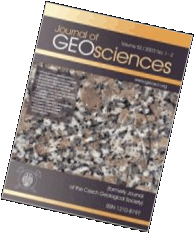 Export to Mendeley
Export to Mendeleymagma mingling
basanite
maar-diatreme volcano
monogenetic volcanism
Cenozoic landscape evolution
basalt locus typicus
Original paper
The Stolpen Volcano in the Lausitz Volcanic Field (East Germany) - volcanological, petrographic and geochemical investigations at the type locality of basalt
Journal of Geosciences, volume 63 (2018), issue 4, 299 - 315
DOI: http://doi.org/10.3190/jgeosci.275
The ~30 Ma Stolpen Volcano near Dresden (Saxony) is situated at the western margin of the Lausitz Volcanic Field. It forms a small isolated basaltic hill, the famous Stolpen Castle Hill, penetrating the granodioritic basement of the Lausitz Block and is worldwide the type locality for the term ’basalt’, as coined by Agricola (1546). The volcano has always been interpreted as subvolcanic crypto- or lava dome.
New geological mapping, dip measurements of the basaltic columnar jointing and the first evidence of scoria for the Stolpen Volcano allow for a new interpretation of the volcanic edifices. On this basis the structure is best described as a maar crater volcano filled by a 110 m thick basanitic lava lake. According to genetic classification, it is a complex monogenetic volcano formed in three phases: (1) a phreatomagmatic diatreme phase with a maar crater, (2) a scoria cone phase with the final basanitic lava lake filling, and (3) a post-volcanic phase with neotectonic uplift, denudation and exposure of a basaltic hill since c. 1.3 Ma. The volcano reconstruction indicates an ongoing change in the eruption style from phreatomagmatic (phase 1) to eruptive and, finally, effusive processes (phase 2) without significant gaps between the eruption episodes. The only difference appears to be caused by a variable water supply during the magma ascent and volcanic eruption.
New mineralogical (QAPF) and geochemical (TAS) investigations of the Stolpen lava samples reveal that the Stolpen Hill is not built by a basalt, but basanite trending toward a nephelinite, following the recent nomenclature. Microscopic analyses also provide evidence of magma mingling, such as nephelinite melt enclaves, and show local lava contamination by the country-rock granodiorite, also supported by the presence of quartz xenocrysts. The combined field observations, petrography and geochemical data indicate overall heterogeneity of the Stolpen lava. Therefore, the Stolpen Castle Hill is not - in a scientific sense - a suitable type locality for either basalt or basanite. However, the outcropping volcanic rocks as well as their scientific and historical importance undoubtedly give relevance to Stolpen as a type locality for basaltic volcanic rocks in a broader sense.
Webdesign inspired by aTeo.
ISSN: 1803-1943 (online), 1802-6222 (print)
email: editor(at)jgeosci.org


IF (WoS, 2024): 1.3
5 YEAR IF (WoS, 2024): 1.4
Policy: Open Access
ISSN: 1802-6222
E-ISSN: 1803-1943